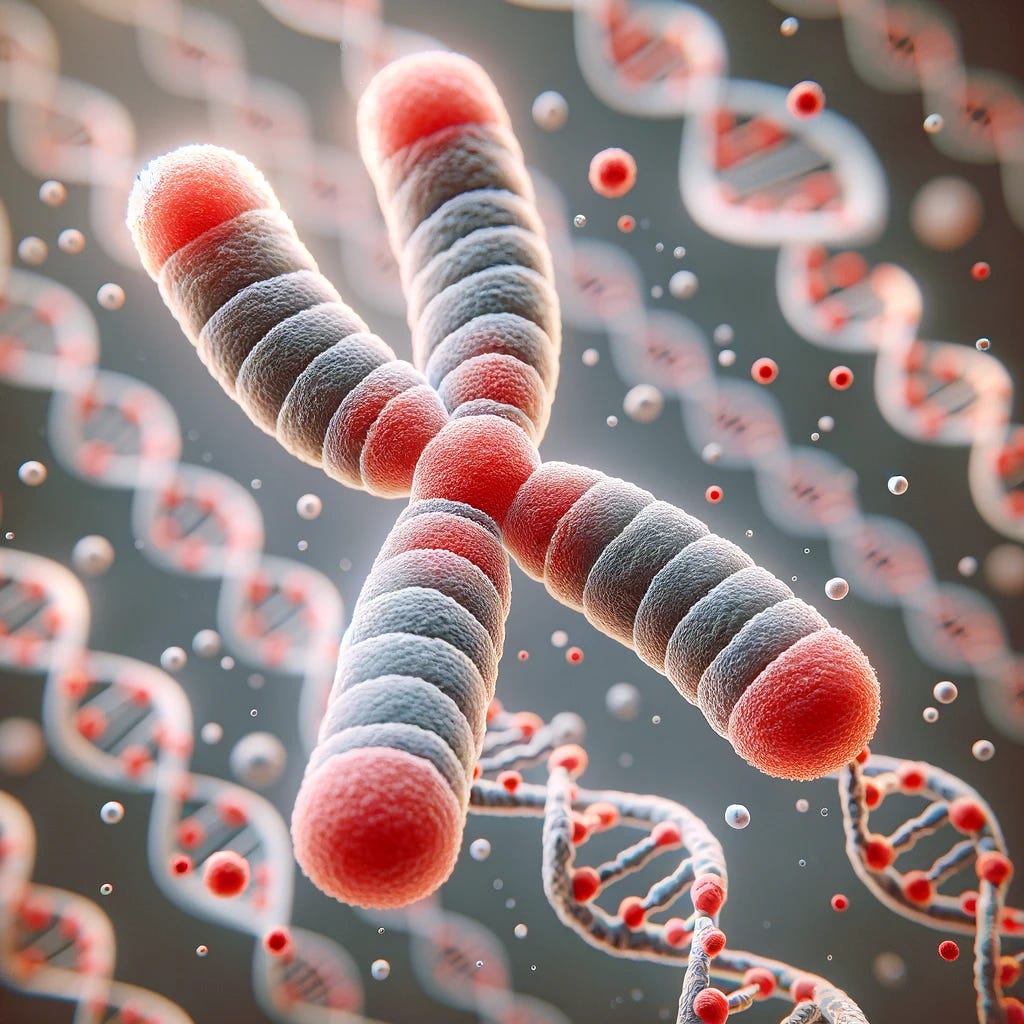The true key to unlocking the secrets of aging
How telomeres hold the key to our biological aging, and how diet, exercise, and stress management help to preserve youthfulness
Ask Google about the value of the anti-aging industry, and you’ll find more than 137 million hits, estimating the industry’s worth between $18 billion and $90 billion annually. Clearly, our fear of looking old, feeling old, and acting old drives significant revenue (and I write about that too here). But what if there was a cellular indicator of our (at least biological) age that we can directly influence with just lifestyle choices? Turns out there is. It’s called your telomeres. Your telemeres are the key to aging.

What are telomeres?
At the very end of our chromosomes are tiny structures called telomeres. Think of these as the plastic tips on shoelaces. Just as these tips prevent shoelaces from fraying, telomeres protect the ends of our chromosomes from deteriorating. Telomeres’ primary role is to ensure our DNA strands are correctly replicated during cell division. As cells divide, a bit of the DNA at the ends of chromosomes is lost. Telomeres serve as a buffer, preventing vital DNA sequences from being lost during this process.
Who cares? What does this really mean, and how are telomeres the key to aging? When I first started learning about telomeres, I was wondering the same thing, too. How can a protective cap on my DNA have any authority over the way my body ages? Silly, right? Well… maybe not….
Cellular aging, cancer, tissue degradation & biological aging
Every time a cell divides, its telomeres become slightly shorter. Over time, as telomeres shorten, the cell loses its ability to divide and dies. This is a natural process, but contributes to aging.
While we think of our age as in the passage of time since birth, biological age refers to how old a person seems. Telomere length can serve as a biomarker for biological age. Those with longer telomeres are often biologically younger than their chronological age. Thus, your telomeres are a key to aging.
- So, if telomere shortening contributes to cellular aging, then retaining telomere length — or at least slowing the shortening process down — can have the reverse effect on it, also leading to a reversal in biological age.
Critically-short telomeres are dangerous to our health, and leads to a cellular instability that can result in cells becoming cancerous because they’re dividing uncontrollably. Basically, the protective effect of the telomere on the cell is lost when the telomere becomes critically short. On the other hand, if cells can no longer divide due to extremely short telomeres, it can lead to tissue degeneration.
“Telomere shortness can even predict people’s statistical risk of developing certain conditions. For instance, for 10 years after their telomeres had been measured, men and women with shorter telomeres were three times more likely than those with longer ones to develop certain types of cancers such as pancreatic cancer5. If elderly, people with shorter telomeres were also 50 percent more likely than those with longer telomeres to develop dementia and 50 percent more likely to die from any particular cause6.” Nature.com
Three times more likely? Fifty percent more likely? These are not minor associations. These are big numbers we should be paying attention to.
- So, telomeres approaching the end of their lifespan can potentially become ineffective, increasing cell division and possibly leading to cancer or tissue degeneration.
This all leads to a very strong argument that our telomeres are the key to aging. So, how can we protect these telomeres? First, you need to look at one of the biggest contributors to their death: The Standard American Diet, often abbreviated as SAD.
How the Standard American Diet (SAD) contributes to telomere death and aging
The SAD features a high intake of red meat, processed foods, dairy, pre-packaged meals, sugary beverages, and desserts, with a low intake of fresh fruits, vegetables, whole grains, and plant proteins. Numerous studies have examined how this diet impacts telomere length and preservation, given the importance of telomeres in cellular health and aging. Here’s what the research suggests:
1. The SAD is nutritionally deficient
The SAD often lacks essential nutrients such as vitamins, minerals, and antioxidants that help with DNA repair and protection. A lack of these nutrients can accelerate telomere shortening. For example, vitamins C and E are known antioxidants that help combat oxidative stress, a significant factor in telomere attrition.
2. The SAD contributes to inflammation
The SAD is rich in foods that promote inflammation, such as trans fats, sugary beverages, dairy and excessive amounts of red meat. Chronic inflammation shortens telomeres. Foods such as processed meats, prevalent in SAD, increase levels of inflammation.
3. The SAD promotes oxidative stress
Foods high in sugar and unhealthy fats can increase oxidative stress in the body. Oxidative stress damages DNA and can accelerate the shortening of telomeres. The low intake of antioxidant-rich foods in the SAD further exacerbates this problem.
4. The SAD encourages obesity and metabolic disorders
There’s a strong correlation between the SAD and the prevalence of obesity and metabolic disorders such as type 2 diabetes. Both obesity and diabetes have been linked to shorter telomere lengths. Fat cells produce inflammatory substances that can contribute to telomere shortening.
5. The SAD neglects fiber intake
Whole grains, fruits, and vegetables, which are often lacking in SAD, are good sources of dietary fiber. Higher-fiber diets link to longer telomere length, possibly due to their role in reducing inflammation and oxidative stress.
By now, you’re most likely thinking, “Great. I’ve already screwed my telomeres. Thanks so much, Kristine!” But wait! There’s research suggesting we can at least protect what we have left, and even regrow the length of our telomeres, through diet, stress reduction and other lifestyle changes.
How to Protect Your Telomeres
- Eat a healthy diet high in plants: Antioxidant-rich foods, such as fruits, vegetables, nuts, and seeds, can combat oxidative stress that attacks our telomeres. Omega-3 fatty acids, found in some nuts, also have protective effects on telomeres.
- Exercise regularly: Physical activity, especially aerobic exercise, links to longer telomeres. Exercise reduces oxidative stress and inflammation.
- Manage your stress: More studies are pointing to stress as a serious risk factor for our health. To me, this indicates our thoughts and feelings really do have an impact on our physical condition. Chronic stress can accelerate telomere shortening. Engaging in relaxation techniques such as meditation, deep breathing exercises, and yoga can help mitigate the effects of stress.
- Get 7 to 9 hours of sleep each night: Sleeping 7-9 hours nightly supports telomere length, as sleep deprivation links to increased oxidative stress.
- Avoid smoking and excessive alcohol: Smoking and excessive alcohol consumption shorten telomeres. Reducing or quitting these habits benefits telomere health.
If the research on our telomeres being the key to aging tells us anything, it’s definitely that we have the power to directly impact our own aging process. So, before you reach for the latest cream, consider what you can do first to help your telomeres live a long, productive life… of making you look and feel young!
Latest Posts:
- Why Midlife Stress Feels Different — and How to Recover from Burnout Naturally
- 5 Sneaky Hormone-Disrupting Foods Women Over 40 Should Ditch
- How to Lower Breast Cancer Risk Naturally: 6 Science-Backed Habits That Work
- 3 Cozy Anti-Inflammatory Recipes to Boost Energy After 40
- Fiber: The Midlife Metabolism Fix You’ve Probably Overlooked








